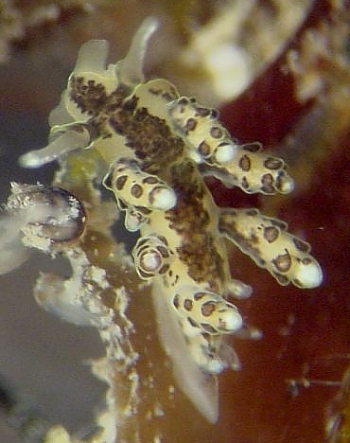
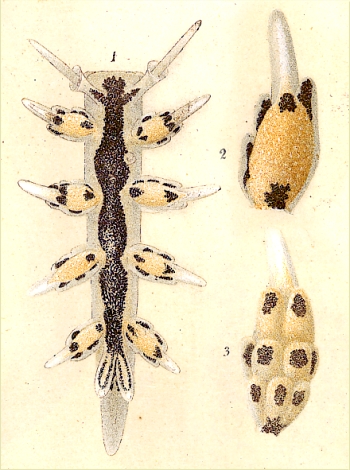
Doto paulinae
Trinchese, 1881
Order: NUDIBRANCHIA
Suborder: DENDRONOTINA
Family: Dotidae
DISTRIBUTION
Known only from the northwestern Mediterranean
PHOTO
Upper: Locality: 'La digue', Port-Leucate , 2m, France, Mediterranean, 12 April 2006. Length: animal : 8mm / eggs : 2mm. Photographer: Marina Poddubetskaia Ossokine. Lower: Original illustration of Doto paulinae from Trinchese, 1881: Plate 58.
The body is translucent with dark brown markings and with yellowish cream colour of the internal organs showing through. In large animals there are 6 pairs of cerata, but often some are missing or in the process of regrowth. The cerata have three rows of tubercles, those on the inside of each ceras being very insignificant. There is no gill [pseudobranch] on the inside of the cerata.
There is a broad brown band down the dorsal midline, between the cerata, which extends forward to the front of the head. On the cerata, there is a rounded brown spot on each tubercle except for the terminal one which is white. When the tubercles on the inside of a ceras are absent, so is the associated brown spot. There is a brown spot at the inside base of each ceras, and in some animals this extends up the inside face of the ceras as a band. This species grows to approximately 10 mm in length.
It is reported bySchmekel & Kress (1977)to feed on Obelia geniculata but is reported by Marina Poddubetskaia Ossokine [message #16426] on Aglaophenia sp.
-
Schmekel, L. & Kress, A. (1977). Die Gattung Doto (Gastropoda: Nudibranchia) im Mittelmeer und Armelicanal, mit Beschreibung von Doto acuta, n. sp. Malacologia, 16(2): 467-499.
-
Schmekel, L. & Portmann, A (1982) Opisthobranchia des Mittelmeeres, Nudibranchia und Saccoglossa. Fauna e Flora del Golfo Napoli, 40: 1-410. Springer-Verlag: Berlin
-
Trinchese, S (1877-79): Aeolididae e famiglie affini del Porto di Genova. Part 1. Anatomia, Fisiologia, Embriologia delle Phyllobranchidae, Hermaeidae, Aeolididae, Proctonotidae, Dotonidae del Porto di Genova. Atlas. Atti della R. Universita di Genova, 2, Pls 1-35.
-
Trinchese, S (1881): Aeolididae e famiglie affini del Porto di Genova. Part 2. Anatomia, Fisiologia, Embriologia delle Phyllobranchidae, Hermaeidae, Aeolididae, Proctonotidae, Dotonidae del Porto di Genova. Memorie della Classe di scienze fisiche, matematiche e naturali, serie 3 11(4 January), 1-142, Pls 1-80.
Rudman, W.B., 2006 (May 3) Doto paulinae Trinchese, 1881. [In] Sea Slug Forum. Australian Museum, Sydney. Available from http://www.seaslugforum.net/find/dotopaul
Related messages
Re: Doto paulinae? from French Mediterranean
May 15, 2006
From: Marina Ossokine
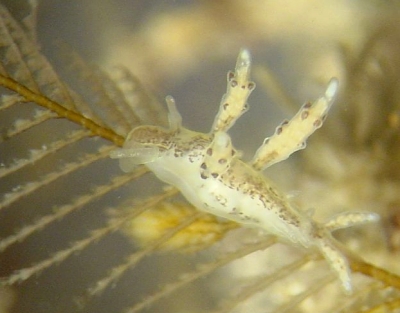
Concerning message #16510:
Dear Bill,
Sorry for this late answer, but I was too busy last days to reply.
I found only 2 specimens of this species and both were on the feather-shaped hydroid visible in photos. As I have already told you, I'm bad in hydroid identification, but the food in question seems to me closer to Aglaophenia than to Obelia.
Also, here is the photo of the second specimen, with autotomised cerata. It fits even better Schmekel & Portmann's drawing than the first one.
Locality: 'La digue', Port-Leucate , 2m, France, Mediterranean, 12 April 2006. Length: 5mm. Photographer: Marina Poddubetskaia Ossokine.
I couldn't tell you more about it, nor explain the food difference.
Best wishes,
Marina.
Nembro website
nembro@nembro.info
Poddubetskaia Ossokine, M., 2006 (May 15) Re: Doto paulinae? from French Mediterranean. [Message in] Sea Slug Forum. Australian Museum, Sydney. Available from http://www.seaslugforum.net/find/16600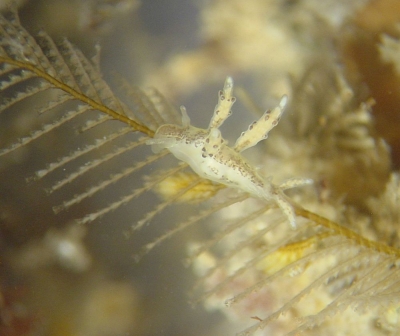
Thanks Marina,
I agree your hydroid doesn't look like Obelia to me, and since you found two animals on this hydroid I guess we can assume they were not there by accident. Since we know so little about these species, linking them to their food can be a useful secondary form of identification. However until we can be sure of its food, this sort of information can be confusing. I think Schmekel & Portmann's feeding record is the only other one, so it's a bit early to say it feeds only on Obelia, or even Obelia at all. Looks like this is another thing to add to your growing 'to do' list.
Best wishes,
Bill Rudman
Re: Doto paulinae? from French Mediterranean
May 4, 2006
From: Marina Poddubetskaia Ossokine
Concerning message #16426:
Dear Bill,
I'm sorry to insist about this detail, but on your Factsheet, Doto floridicola is described as having "the tips of the tubercles ... covered with a dull red spot..." It doesn't fit my animals who have white terminal tubercles.
Best wishes,
Marina.
nembro@nembro.info
Poddubetskaia Ossokine, M., 2006 (May 4) Re: Doto paulinae? from French Mediterranean. [Message in] Sea Slug Forum. Australian Museum, Sydney. Available from http://www.seaslugforum.net/find/16510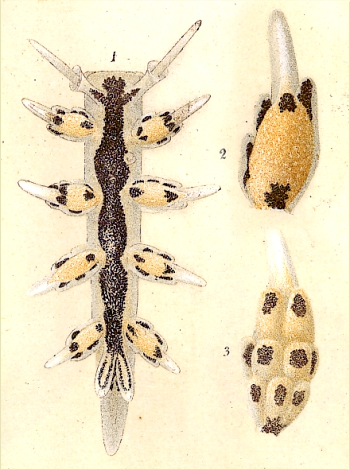
Dear Marina,
You are of course quite right. I should have been more confident of my Fact Sheets! When I got your photos I checked Schmekel & Portmann (1982) and got misled by their description which talks of 'minute brown red or brown dots' but never actually says the minute dots are arranged in large spots or a median band. I guess it's a case of 'not seeing the forest for the trees'. After getting your message I did what I should have done first, and relooked at Trinchese's original description. His illustration, (Plate 58), which I post alongside, is almost identical to your photo. I guess the only difficulty now is that your animals were on Aglaophenia while Schmekel & Portmann report it from Obelia. As species of Doto seem to be very specific in their food choices it would be useful if you could confirm your animals are on Aglaophenia.
I have prepared a Fact Sheet for D. paulinae
Best wishes,
Bill Rudman
Doto paulinae? from French Mediterranean
May 1, 2006
From: Marina Poddubetskaia Ossokine
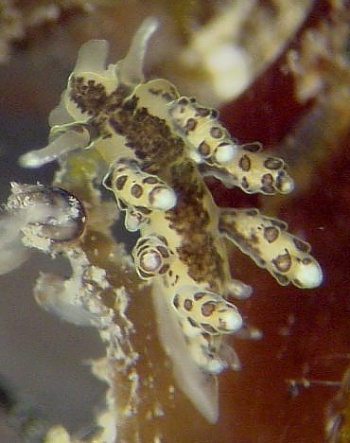
Dear Bill,
I need your help to identify this distinctive Doto from the Mediterranean coast of France. Is it Doto paulinae, please ? It looks similar to Doto floridicola, but with brown pigmentation and white terminal ceratal tubercle.
I found it on Aglaophenia and I saw it laying this egg-ribbon (maybe not finished because I disturbed the animal).
Locality: 'La digue', Port-Leucate , 2m, France, Mediterranean, 12 April 2006. Length: animal : 8mm / eggs : 2mm. Photographer: Marina Poddubetskaia Ossokine.
Thank you in advance.
All the best,
Marina.
Nembro website
nembro@nembro.info
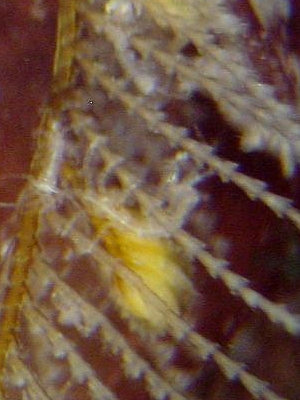

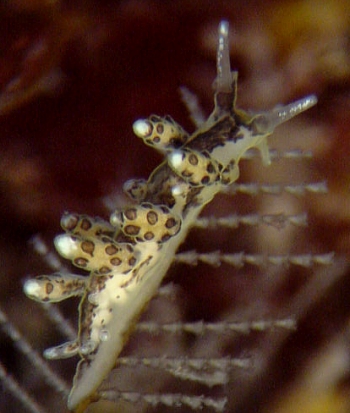
Dear Marina,
I could be quite wrong but I suspect this is a dark brown form of D. floridicola, but as I don't know if this species has a brown form I would welcome some feedback from local experts. The descriptions of D. paulinae I have looked at don't show any particular distinctive colour features I could say fit your animals. More importantly, D. paulinae is reported to feed on Obelia geniculata while you say your species, like D. floridicola, feeds on Aglaophenia. Since species of Doto seem to be quite specific feeders, I suspect your animal is not D. paulinae. I welcome some local advice, but my guess is that it is probably a colour form of D. floridicola.
Best wishes,
Bill Rudman
